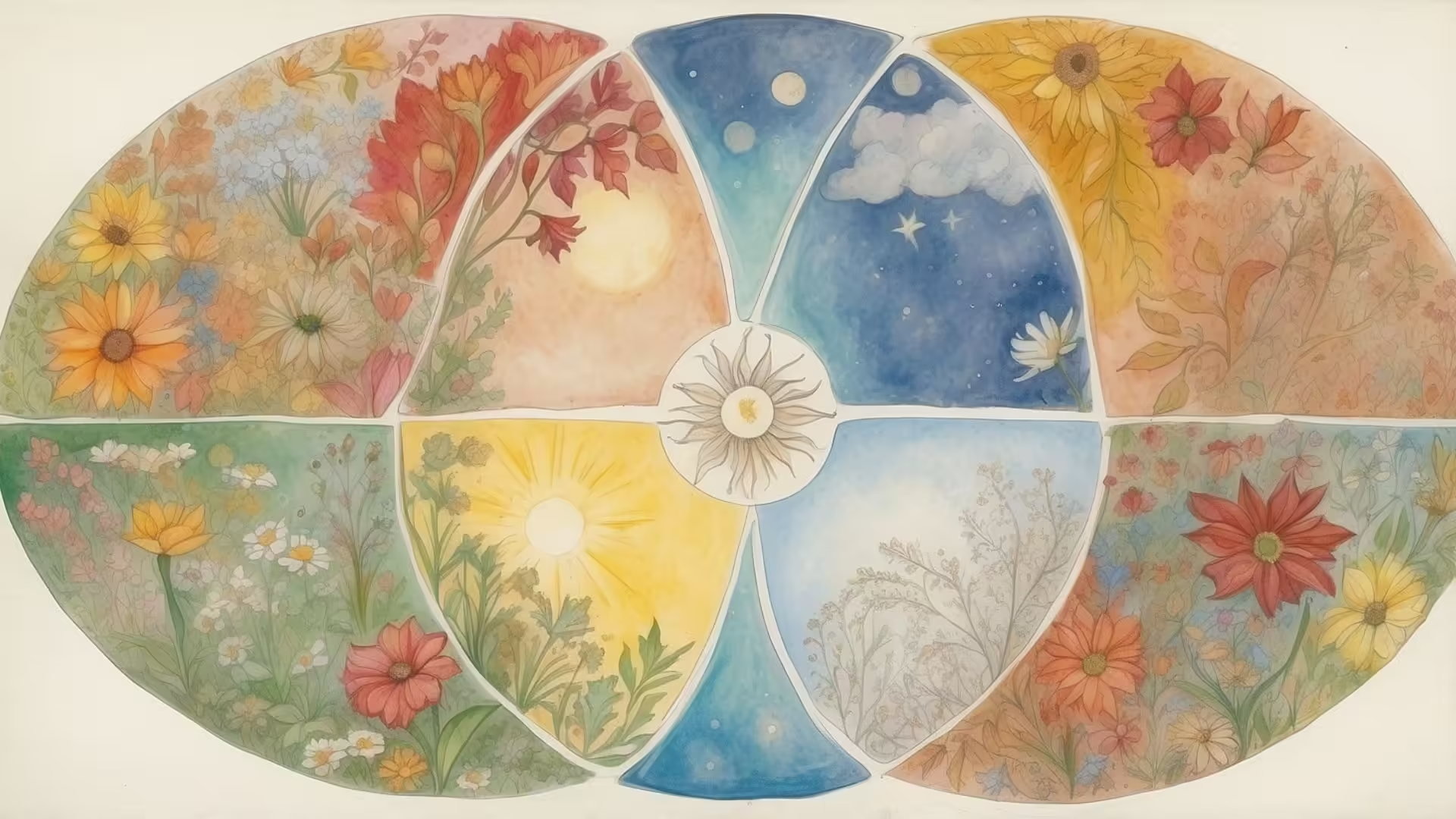The Gist
The Seasons: Earth’s Annual Cycle
The changing of the seasons is one of Earth’s most familiar and fundamental cycles. Whether you’re enjoying a warm summer day or watching the leaves change color in autumn, the seasons shape our lives in countless ways. But why do we have seasons, and what exactly causes them? To fully understand the magic behind Earth’s annual cycle, we need to take a closer look at how our planet’s tilt and orbit around the sun work together to create these changes.
What Causes the Seasons?
The seasons are the result of Earth’s 23.5-degree axial tilt. This tilt means that as Earth orbits around the sun, different parts of the planet receive varying amounts of sunlight throughout the year. When the Northern Hemisphere is tilted toward the sun, it experiences summer, while the Southern Hemisphere, tilted away from the sun, is in winter. Six months later, the roles reverse.
It’s important to note that the seasons aren’t caused by the distance between Earth and the sun. In fact, Earth is closest to the sun during the Northern Hemisphere’s winter and farthest away during summer. The real reason for seasonal change is the angle at which sunlight hits Earth’s surface. When sunlight strikes more directly, it’s stronger and warms the surface more, leading to summer. When the sunlight is spread out over a larger area, it’s less intense, creating winter.
The Four Seasons and Their Characteristics
- Spring: Often seen as a time of renewal, spring marks the period when days start to get longer and temperatures begin to rise. Plants start blooming, animals become more active, and the world seems to wake up from its winter slumber.
- Summer: This is when the sun’s rays are most direct, leading to warmer temperatures and longer days. In many regions, summer is a time for growth, abundance, and outdoor activities. It’s also the season with the most sunlight and the hottest weather.
- Autumn (or Fall): As the Earth continues its journey around the sun, the days grow shorter, and temperatures cool. Autumn is often associated with harvest time, as many crops reach maturity. The colorful transformation of leaves is one of the season’s most iconic features.
- Winter: When the hemisphere is tilted away from the sun, we experience winter. Days are shorter, and temperatures drop. For some, winter means snow and ice, while others might experience milder but still cooler weather.
How the Seasons Affect Life on Earth
The changing seasons have a profound impact on all living things. Plants and animals have adapted to the rhythms of Earth’s annual cycle, timing their growth, reproduction, and migration with the seasons. In spring, many species breed and give birth, taking advantage of the warmer temperatures and abundance of food. By autumn, some animals begin preparing for winter by storing food or migrating to warmer climates.
Humans, too, have developed seasonal habits. Agricultural practices are deeply tied to the seasons, with planting, growing, and harvesting scheduled around the weather. Even modern life, with its technology and conveniences, is still influenced by the changing seasons. From holiday traditions to summer vacations, the seasons shape our routines, culture, and even our moods.
The Solstices and Equinoxes
The seasons are marked by two key astronomical events: solstices and equinoxes.
- Solstices: These occur twice a year when the sun reaches its highest or lowest point in the sky at noon, marking the longest and shortest days. The summer solstice occurs around June 21st, and the winter solstice happens around December 21st. The summer solstice is the longest day of the year, while the winter solstice is the shortest.
- Equinoxes: Equinoxes occur when the day and night are roughly equal in length. The spring equinox happens around March 21st, and the autumn equinox falls around September 23rd. These events signal the changing of the seasons and the transition from one half of the year to the next.
The Seasons and Climate Change
In recent years, climate change has started to disrupt the familiar patterns of the seasons. Winters are becoming shorter and milder in some places, while summers are growing longer and hotter. These shifts are affecting ecosystems and agriculture, as species struggle to adapt to the rapid changes in their environments. While Earth’s natural tilt and orbit will continue to create the seasons, human activities are influencing the intensity and timing of these seasonal changes, with consequences that are still being studied.
The seasons are an integral part of life on Earth, shaping ecosystems, cultures, and even our daily routines. By understanding the science behind Earth’s annual cycle, we can better appreciate the balance of nature and how the tilt of our planet plays such a crucial role in our lives. As we continue to observe shifts in these patterns due to climate change, it’s important to recognize the delicate balance that makes each season unique and vital.
Let’s Talk
So, now that we’ve covered how Earth’s tilt and orbit give us the seasons, isn’t it amazing how something as simple as a 23.5-degree tilt creates such a huge impact on our daily lives? I mean, think about it—without that tilt, we wouldn’t have the changing seasons at all. Imagine living in a world where the weather is the same all year round. Would we miss the cold winter mornings, or the crisp autumn air, or even those long summer days that seem to stretch on forever?
It’s funny, though, how we sometimes take the seasons for granted, right? Spring comes, we dust off our lighter clothes, and we’re ready for flowers and warmer days. Summer hits, and it’s all about vacations and soaking up the sun. But we don’t often stop to think about the science behind it all. The seasons are part of the rhythm of life, and they shape so much of what we do, from the food we eat to the holidays we celebrate.
And here’s something that wasn’t mentioned earlier: how the seasons can affect our mood. Ever heard of seasonal affective disorder (SAD)? It’s a form of depression that’s linked to the changing seasons, especially as the days get shorter in fall and winter. It’s wild to think that the amount of sunlight we get during different seasons can have such a huge impact on how we feel. So, in a way, the tilt of the Earth doesn’t just change the weather—it can change our entire mood and energy levels! I’ve noticed that I definitely feel more energized in the summer. What about you? Do you notice how your energy or mood shifts with the seasons?
Another thing to think about is how different parts of the world experience the seasons. While we’re enjoying a sunny day in summer, the Southern Hemisphere is in the middle of winter! It’s kind of cool to imagine the world spinning through space, with one half soaking up the sun while the other is bundling up in scarves and coats. If you’ve ever traveled between hemispheres, you know the strange feeling of jumping from one season to another. Have you ever traveled somewhere and suddenly realized it was a completely different season than you were used to?
And then there’s the practical side of things. How the seasons affect our daily lives in ways we might not even notice. Take agriculture, for example. The seasons determine when crops are planted and harvested, which impacts everything from food supply to economy. Even our social calendars revolve around the seasons—think about how many events, festivals, and holidays are linked to specific times of the year. It’s kind of like nature’s clock, guiding our lives without us even realizing it.
Of course, we can’t ignore the fact that climate change is starting to mess with these patterns. Winters aren’t as cold as they used to be in some places, and summers seem to be stretching out longer and getting hotter. It’s a little unsettling to think about how this could affect ecosystems, wildlife, and even our own routines in the future. What do you think? Have you noticed any changes in the seasons where you live?
So, the next time the seasons start to shift, maybe take a moment to appreciate the science behind it. That slight tilt of the Earth that keeps everything in balance—and think about how different life would be if that tilt didn’t exist. It’s pretty mind-blowing when you really stop to consider it! Let’s talk about how the seasons shape your life—what’s your favorite time of year, and how do you think the changing seasons affect you?
Let’s Learn Vocabulary in Context
Let’s break down some of the key words and phrases that came up when we were talking about the seasons and how Earth’s tilt shapes them. These are terms we might hear all the time, but when you stop and think about how they’re used, they really give you a better understanding of the world around us.
First, let’s look at axial tilt. This phrase sounds technical, but it’s really just describing the fact that Earth isn’t perfectly upright as it orbits the sun—it’s tilted at an angle of 23.5 degrees. This tilt is what causes the seasons. In everyday conversation, you probably wouldn’t use the phrase “axial tilt,” but you could say something like, “Did you know that Earth’s tilt is the reason we have seasons?” It’s a cool little fact to throw out when the weather changes.
Next up is solstice. We mentioned how solstices mark the longest and shortest days of the year. The summer solstice is when we get the most daylight, and the winter solstice is when we get the least. You could use this word when talking about specific times of year, like, “The days will start getting longer after the winter solstice.” It’s a handy word to explain why the daylight hours change so dramatically.
Then there’s equinox. An equinox happens twice a year, when day and night are nearly equal in length. It’s the halfway point between the solstices. In real life, you might use it to explain why spring and fall feel so balanced in terms of daylight, like, “Around the equinox, we get about the same amount of daylight and night.”
Let’s not forget precipitation, which came up earlier. In the context of seasons, precipitation refers to the rain, snow, sleet, or hail we experience throughout the year. Different seasons bring different types of precipitation, like spring showers or winter snow. In conversation, you could say something like, “We’re expecting a lot of precipitation this week,” when you know rain or snow is on the way.
And finally, climate change. This is a big one. We talked about how climate change is affecting the seasons, making winters shorter and summers longer in some areas. Climate change is a term you probably hear a lot, and it refers to the long-term changes in Earth’s weather patterns, largely due to human activity. You could bring it up in a conversation like, “I’ve noticed that the seasons have been a little off lately—probably because of climate change.”
Now, here are a couple of questions to get you thinking: How do the changing seasons affect your daily life, and have you noticed any differences in the seasons due to climate change? Let’s dive into that!











0 Comments